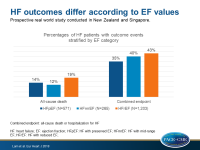CV risk remains high up to 5 years after TIA or minor stroke
Patients with a transient ischemic attack or minor stroke had a sustained elevated risk of CV events up to 5 years after the first event, and approximately half of these events occurred after the first year.
Five-Year Risk of Stroke after TIA or Minor Ischemic StrokeLiterature - Amarenco P, Lavallee PC, Monteiro Tavares L, et al. - New Engl J Med 2018; published online ahead of print
Introduction and methods
The risk of adverse outcomes in patients suffering a transient ischemic attack (TIA) or minor ischemic stroke at 1 year is elevated [1-3]. However, there are limited data on the risk of adverse outcomes beyond 1 year in these patients.
The TIAregistry.org project was designed to evaluate the short- and long-term outcomes of patients with a recent TIA or minor stroke. The short-term outcomes (at 3 months and 1 year) have been reported [3]. This analysis assessed the long-term part of the registry.
Patients aged ≥18 years with a TIA or minor stroke within the previous 7 days were enrolled in the registry from 2009 to 2011. The specifics of the cerebral ischemic events were: focal retinal or brain ischemia with resolution of symptoms or minor strokes and a score on the modified Rankin scale of 0 or 1. For this analysis, 42 out of 61 registry sites were selected, because they had available follow-up data on more than 50% of their enrolled patients at 5 years (N=3847). ABCD2 scores were calculated (range: 0-7) based on age, blood pressure, clinical findings, duration of symptoms, and presence or absence of diabetes), with higher scores indicating a greater risk of stroke.
The primary outcome was the first occurrence of a composite of CV death, non-fatal stroke (ischemic or hemorrhagic), or non-fatal acute coronary syndrome (ACS). Secondary outcomes included individual components of the primary outcome, TIA recurrence, all-cause death, bleedings according to the GUSTO definitions [4], and the modified Rankin score at last follow-up.
Main results
During the median follow-up time of 5.01 years (IQR: 4.84-5.26):
- 469 patients had a primary outcome event (12.9%), out of which 235 (50.1%) occurred during years 2-5
- 345 patients had a stroke (9.5%) with 149 (43.2%) during years 2-5
- 373 patients (10.6%) died of any reason
- 96 patients (2.7%) died from CV causes
- 621 patients (16.8%) had a recurrent stroke or TIA
- 84 patients (2.4%) had an ACS
- 53 patients (1.5%) had a major bleeding and 39 patients (1.1%) had an intracranial bleeding
- 299 (7.9%) had a combination of the primary outcome and a modified Rankin score >1
Independent predictors of recurrent stroke during years 2 to 5 were ipsilateral large-artery atherosclerosis, cardio-embolism, and an ABCD2 score ≥4.
Conclusion
Patients with a TIA or minor stroke in the TIAregistry.org project had a sustained elevated risk of CV events up to 5 years after the first event, whereas approximately half of the recurrent events occurred after the first year. Independent predictors of recurrent stroke (ipsilateral large-artery atherosclerosis, cardio-embolism, ABCD2 score ≥4) can be used to intensify secondary prevention in these patients, 2-5 years after the first event.
References
1. Lavallée PC, Meseguer E, Abboud H, et al. A transient ischaemic attack clinic with round-the-clock access (SOS-TIA): feasibility and effects. Lancet Neurol 2007; 6: 953-60.
2. Rothwell PM, Giles MF, Chandratheva A, et al. Effect of urgent treatment of transient ischaemic attack and minor stroke on early recurrent stroke (EXPRESS study): a prospective population-based sequential comparison. Lancet 2007; 370: 1432-42.
3. Amarenco P, Lavallée PC, Labreuche J, et al. One-year risk of stroke after transient ischemic attack or minor ischemic stroke. N Engl J Med 2016; 374: 1533-42.
4. The GUSTO Investigators. An international randomized trial comparing four thrombolytic strategies for acute myocardial infarction. N Engl J Med 1993; 329:673-82.

